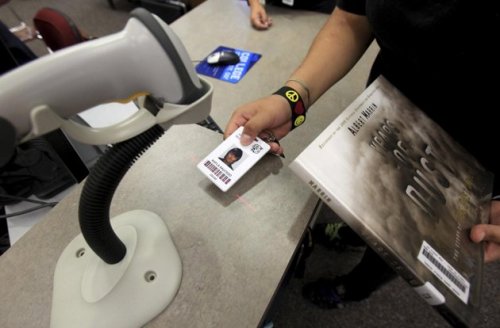
In this Oct. 1, 2012 photo, Kayla Saucedo, an 8th grader at Anson Jones Middle School, uses her new ID card to check out a book in the library in San Antonio, Texas. The San Antonio school district’s website was hacked over the weekend to protest its policy requiring students to wear microchip-embedded cards tracking their every move on campus. A teenager purportedly working with the hacker group Anonymous said in an online statement that he took the site down because the Northside school district “is stripping away the privacy of students in your school.” All students at John Jay High School and Anson Jones Middle School are required to carry identification cards embedded with a microchip. They are tracked by the dozens of electronic readers installed in the schools’ ceiling panels. (AP Photo/San Antonio Express-News, Bob Owen)
By Jim Forsyth
SAN ANTONIO (Reuters) – A public school district in Texas can require students to wear locator chips when they are on school property, a federal judge ruled on Tuesday in a case raising technology-driven privacy concerns among liberal and conservative groups alike.
U.S. District Judge Orlando Garcia said the San Antonio Northside School District had the right to expel sophomore Andrea Hernandez, 15, from a magnet school at Jay High School, because she refused to wear the device, which is required of all students.
The judge refused the student’s request to block the district from removing her from the school while the case works its way through the federal courts.
The American Civil Liberties Union is among the rights organizations to oppose the district’s use of radio frequency identification, or RFID, technology.
“We don’t want to see this kind of intrusive surveillance infrastructure gain inroads into our culture,” ACLU senior policy analyst Jay Stanley said. “We should not be teaching our children to accept such an intrusive surveillance technology.”
The district’s RFID policy has also been criticized by conservatives, who call it an example of “big government” further monitoring individuals and eroding their liberties and privacy rights.
The Rutherford Institute, a conservative Virginia-based policy center that represented Hernandez in her federal court case, said the ruling violated the student’s constitutional right to privacy, and vowed to appeal.
The school district – the fourth largest in Texas with about 100,000 students – is not attempting to track or regulate students’ activities, or spy on them, district spokesman Pascual Gonzalez said. Northside is using the technology to locate students who are in the school building but not in the classroom when the morning bell rings, he said.
Texas law counts a student present for purposes of distributing state aid to education funds based on the number of pupils in the classroom at the start of the day. Northside said it was losing $1.7 million a year due to students loitering in the stairwells or chatting in the hallways.
The software works only within the walls of the school building, cannot track the movements of students, and does not allow students to be monitored by third parties, Gonzalez said.
The ruling gave Hernandez and her father, an outspoken opponent of the use of RFID technology, until the start of the spring semester later this month to decide whether to accept district policy and remain at the magnet school or return to her home campus, where RFID chips are not required.









